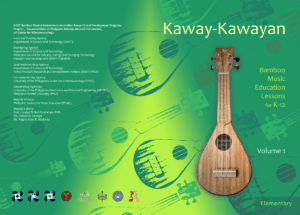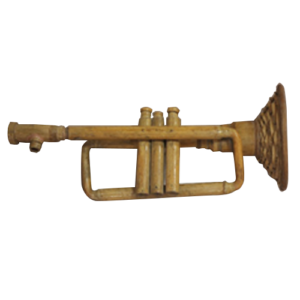Elementary Module
MUSIKONG BUMBONG OF TONSUYA, MALABON
- Volume 1
Background

- Bagong Silang Overture perf by Tonsuya Musikong Bumbong Ensemble – Link to Resource
- Marcha Pilipino No. 1 arr by Gilbert Ramos – Link to Resource
- Marcha Pilipino No. 2 arr by Gilbert Ramos – Link to Resource
- Buho Trombone shaped – Link to Resource
- Bumbong bamboo tubes – Link to Resource
- Alto Rambusa saxophone – Link to Resource
- Buho2 Trombone shaped – Link to Resource
- Bamban Trumpet shaped – Link to Resource
- Identify Visually and Aurally the instrument – Link to Resource
- Interview with Gilbert Ramos on Tonsuya, Malabon Musikong Bumbong – Link to Resource
I. OBJECTIVES
A. Content Standards
Demonstrates understanding of variations of sound density in music (lightness and heaviness) as applied to instrumental music
B. Performance Standards
- Participates in a group performance to demonstrate different instrumental sounds
C. Learning Competencies/Objectives
- Identifies aurally and visually the different instruments of the Tonsuya, Malabon Musikong Bumbong
- Participates actively in musical ensemble
- Creates a variety of sounds emanating from the environment using available Sound resources
Musikong Bumbong of Tonsuya, Malabon
A. References
- Teacher’s Guide pages
- Learner’s Materials pages
- Print Materials
- Textbook pages
- Additional Materials from Learning Resources Management and Development System portal: http://tiny.cc/BMI-Malabon-GDrive
B. Other Learning Materials Online
A. Reviewing Previous Lesson
Identifies aurally and visually the instruments in:
rondalla
drum and lyre band
B. Establishing a Purpose for the Lesson
Discuss with the students that through this lesson on the Musikong Bumbong of Tonsuya, Malabon, they will be able to: discuss the history and the significance of the bamboo ensemble to the history of the Filipino nation and to the Philippine musical tradition; identify visually and aurally the basic instruments of the ensemble; explain the functions of the instruments; describe how the instruments are played; describe the repertoire, functions and uses of the bamboo ensemble and develop an appreciation to the Tonsuya, Malabon Musikong Bumbong.
C. Presenting the New Lesson
-
- Watch a video performance of the Musikong Bumbong of Tonsuya, Malabon – Marcha Pilipino No. 1, arranged by Gilbert Ramos:
https://tiny.cc/BMI-Marcha-Pilipino1 Instruct students to write down the instruments they recognize while watching the video presentation Take note: Assignment during the previous session:- Research on the Musikong Bumbong of Tonsuya, Malabon. Be able to discuss the following:
- Historical Background
- Instrumentation
- Repertoire
- Function and Uses
- Research on the Musikong Bumbong of Tonsuya, Malabon. Be able to discuss the following:
- Watch musical performances of the ensemble (online, CDs, any recordings, etc.) Interview with Gilbert Ramos/Ethnography on the Musikong Bumbong of Tonsuya, Malabon: https://tiny.cc/BMI-Interview-GRamos
- Watch a video performance of the Musikong Bumbong of Tonsuya, Malabon – Marcha Pilipino No. 1, arranged by Gilbert Ramos:
D. Discussing New Concepts and Practicing New Skills #1
- Ask students to identify the instruments they recognize in the video presentation and to write them on the board.(Teacher has the option to make this activity a form of recitation or a form of game or competition by dividing the whole class into 3-4 groups. Given a specified time, the group with the highest number of correct answers and finishes early wins the game.)
- Watch video recordings of the different instruments of Tonsuya, Malabon Musikong Bumbong:
- Buho Trombone shaped:
https://tiny.cc/BMI-Buho-trombone - Buho2 Trombone shaped:
https://tiny.cc/BMI-Buho-trombone2 - Bumbong bamboo tubes:
https://tiny.cc/BMI-Bumbong-bambootubes - Alto Rambusa saxophone:
https://tiny.cc/BMI-Alto-Rambusa-sax - Bamban Trumpet shaped:
https://tiny.cc/BMI-Bamban-trumpet
- Buho Trombone shaped:
- Ask students to describe how the instruments are played as well as the functions of the instruments as presented in the videos.Teacher may add to the discussion the instruments the students fail to mention as well as the other percussive instruments employed in the Musikong Bumbong of Tonsuya, Malabon.
E. Discussing New Concepts and Practicing New Skills #2
- Discuss the historical background of the Tonsuya, Malabon Musikong Bumbong in terms of:
- Date and place of establishment
- Founder/s
- How and why the group was established
- Membership
- Maker of instruments
- Historical development
- Describe the repertoire of Tonsuya, Malabon Musikong Bumbong and discuss the uses and functions of its music to the members and listeners.
- Discuss the role of Tonsuya, Malabon Musikong Bumbong in the history of the Filipino nation and its contribution to the Philippine musical tradition.
Simulation Activity: Banda de Voca
Group Activity:
Divide the class into 3-4 groups. Ask each group to choose their leader.
Instruction:
Each group will choose any of the Philippine folk songs they have learned. Using their voice (simulate Banda de Voca), the students will imitate the timbre of the instruments of Tonsuya, Malabon Musikong Bumbong as well as simulate how the instruments are played while performing the Philippine folk song they have chosen. Each group will be given 5-8 minutes to prepare for a 2–3-minute presentation. Teacher will use a Rubric as basis for giving feedback, comments, or grades to each of the students’ group presentations. (Teacher discusses with the class the items in the rubrics before students are given the go signal to practice by groups so they are informed about the basis for the feedback, comments, and grade they will receive.)
F. Developing Mastery (Leads to Formative Assessment)
Watch another video performance of the Tonsuya Musikong Bumbong: Bagong Silang Overture
Teacher pauses the video and points to a specific instrument and asks students to:
- Identify the instrument
- Describe how the instrument is played
G. Finding Practical Applications of Concepts and Skills in Daily Living
Ask students to observe and survey the things they see in their school, home, community, city, or province and identify which among those they see or have observed are potential source/s of musical sound. Ask them to enumerate these things and explain or demonstrate (if possible) briefly the way, or manner a musical sound may be produced or generated.
After 3 – 5 examples given by the students, ask them what this exercise/activity has taught them as an individual or member of a school, community, household, or citizen of a nation. (Possible answers maybe: resourcefulness; creativity; practicality; keen observant; being musical; etc.)
H. Making Generalizations and Abstractions About the Lesson
Let the students discuss the following briefly:
- Historical background of Tonsuya Musikong Bumbong; its role in Philippine history and its contribution to the Philippine musical tradition
- Identify visually and aurally the basic instruments of the ensemble through video presentation – https://tiny.cc/BMI-Identify-Instruments
- The functions of the instruments
- Describe the repertoire, functions, and uses of the Tonsuya Malabon Musikong Bumbong
I. Evaluating Learning
Quiz – (1-10 Items) Multiple Choice:
Items: 1 – 4; Content – founder, date of establishment, original members; function and use; historical significance
Listening Test:
Items: 5-6 Identify the instruments heard (mp3) – https://tiny.cc/BMI-Identify-Instruments
Identification and Classification
Items: 7 – 10; Identify the instruments shown in the pictures/video or actual instruments (if there are available) – https://tiny.cc/BMI-Identify-Instruments
J. Additional Activities for Application
Group Activity: Simulation Activity 2 – Banda Musiko
Grouping follows the grouping made in Simulation Activity 1. This group activity will be presented in the next session.
Instruction:
Each group will employ Marcha Pilipino No. 1 arranged by Gilbert Ramos. Using improvised bamboo instruments, and other percussive instruments available, the students will imitate and provide accompaniment to the piece Marcha Pilipino No. 1 creatively. The students will imitate and simulate the instruments of Tonsuya, Malabon Musikong Bumbong while the audio file of Marcha Pilipino No. 1 is being played. Teacher will use a Rubric as basis for giving feedback, comments, or grades to each of the students’ group presentation. Teacher discusses with the class the items in the rubrics so they are informed about the basis for the feedback, comments, and grade they will receive.
VI. Reflection
a. How many learners earned 80% in the evaluation? How many learners require additional activities for remediation?
b. Did the remedial lesson work? How many learners have caught up with the lesson? How many learners continue to require remediation?
c. Which of my teaching strategies worked well? Why did this work?
d. What difficulties can my principal or supervisor help me solve?
e. What innovation or localized materials did I use/discover which I wish to share with other teachers?
Science in a creative industry.
The DOST-FPRDI has a Bamboo Musical Instruments Innovation R&D program aimed at improving the quality of locally-made bamboo musical instruments (BMIs) through science and innovative technologies. The program seeks to standardize the production of selected BMIs, develop prototype designs, analyze raw material sources and existing markets, and build a BMI processing facility. In addition, the program aims to document the ethnocultural story behind several BMIs and identify the bamboo species used in BMI production to promote public awareness and appreciation of the cultural importance of these musical instruments. The program is a collaboration with the University of the Philippines and Philippine Normal University for teaching modules and analyzing sound quality and standardization of BMI design. The DOST Grants-in-Aid program provides funding.
PhBMI

